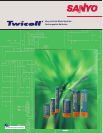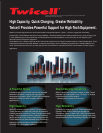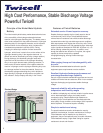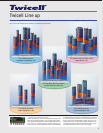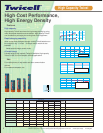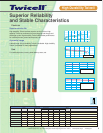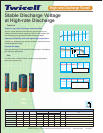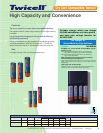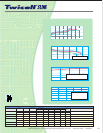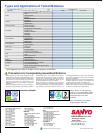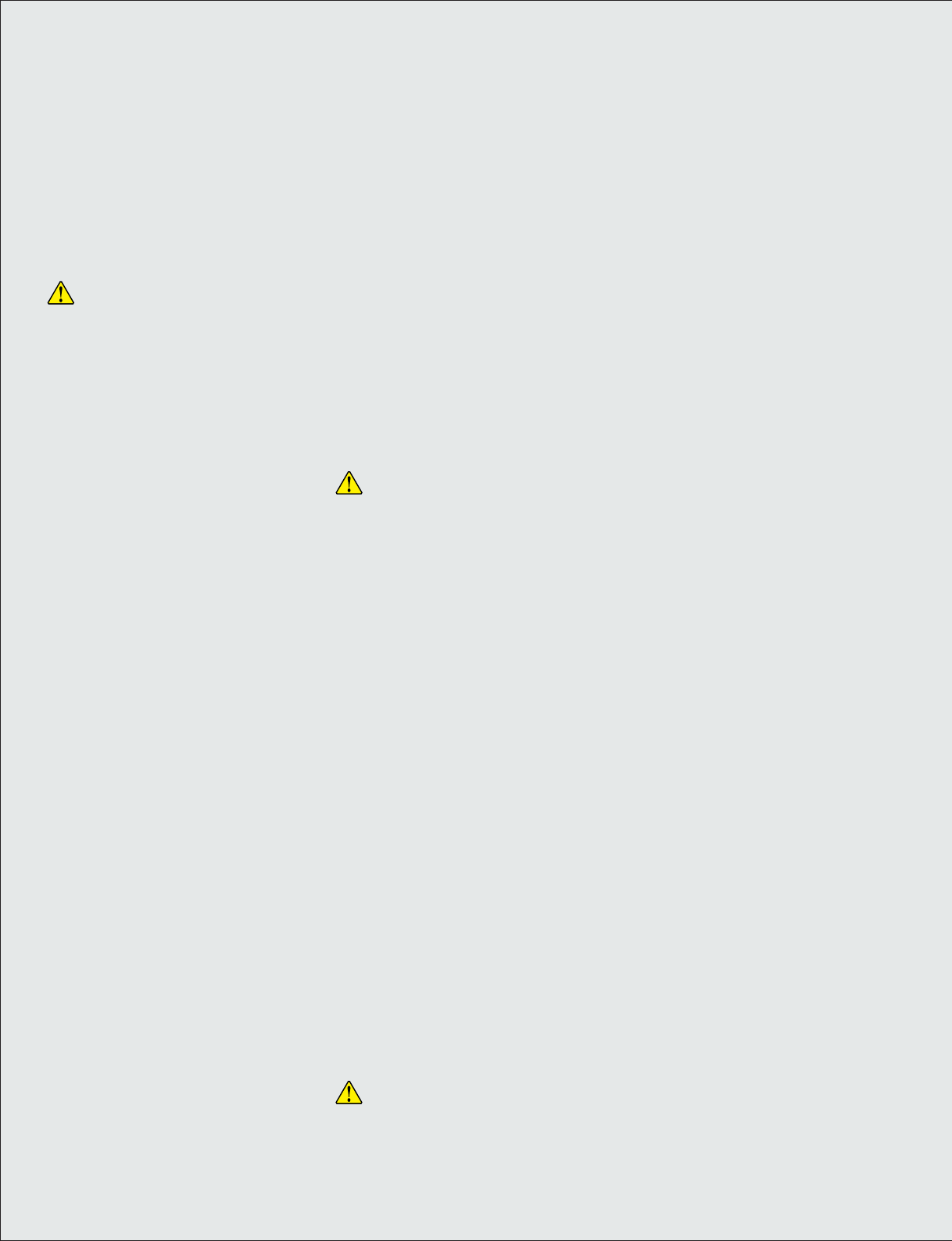
Carefully read this instruction manual before using Twicell batteries for the first time.
Important:For your safety and that of your customers observe all cautionary information provided in
this manual. Save this manual for future reference. The following information is intended to highlight
potential safety hazards that can be associated with the misuse, misapplication or damage to Twicell
batteries. Please carefully evaluate the information in this section when using Twicell batteries (single
cell or packed cells) or when using or manufacturing equipment incorporating Twicell batteries.
This manual is no substitute for your independent evaluation of equipment incorporating Twicell batter-
ies. Customers incorporating Twicell batteries into their equipment must assure that their completed
product has been properly designed, manufactured and tested. End users of equipment incorporating
Twicell batteries should also be provided with sufficient warnings and instructions on their safe opera-
tion. As appropriate, some or all of the following warnings and information should be incorporated by
you into the instruction manual accompanying your equipment.
DANGER!
Failure to carefully observe the following proce-
dures and precautions can result in leakage of bat-
tery fluid (electrolyte), heat generation, bursting,
fire and serious personal injury!
Never dispose of Twicell batteries in a fire or heat
them.
Doing so may melt the insulation, damage the gas
release vents or protective devices, ignite hydro-
gen gas, cause leakage of battery fluid (electro-
lyte), heat generation, bursting and fire.
Do not connect the
(positive) and (negative)
terminals of Twicell batteries together with electri-
cally conductive materials, including lead wires. Do
not transport or store Twicell batteries with their
uncovered terminals or connected with a metal
necklace or other conductive material. Doing so
may short circuit a battery, which would result in
excessive current flow and possibly cause leakage
of battery fluid, heat generation, bursting and fire.
When carrying or storing batteries, use a special
case.
Only charge Twicell batteries using those specific
chargers that satisfy Sanyo’s specifications. Only
charge batteries under the conditions specified by
Sanyo. Failure to follow proper charging proce-
dures may cause excessive current flow, loss of
control during charging, leakage of battery fluid,
heat generation, bursting and fire.
Never disassemble Twicell batteries. Doing so
may cause an internal or external short circuit or
result in exposed material of battery reacting
chemically with the air. It may also cause heat
generation, bursting and fire. Also, this is danger-
ous as it may cause splashing of alkaline fluid.
Never modify or reconstruct Twicell batteries.
Protective devices to prevent danger are built into
batteries(single cell or packed cells). If these are
damaged, excessive current flow may cause loss
of control during charging or discharging of the bat-
tery, leakage of battery fluid, heat generation,
bursting and fire.
Never solder lead wires directly on to Twicell bat-
teries.
The heat of the soldering operation may melt the
insulation, damage the gas release vents or pro-
tective devices, cause leakage of battery fluid, heat
generation, bursting and fire.
The
(positive) and (negative) terminals of Twi-
cell batteries are predetermined. Do not force the
terminal connection to a charger or equipment. If
the terminals can not be easily connected to the
charger or equipment, check if the
and termi-
nals are correctly positioned. If the terminals are
reversed, during charging the battery may be dis-
charged rather than charged. Furthermore, re-
versed connections may cause abnormal chemical
reaction in the battery, the flow of abnormal cur-
rents, leakage of battery fluid, heat generation,
bursting and fire.
The gas release vent which release internal gas is
located in the
positive terminal of the Twicell bat-
tery. For this reason, never deform this section or
cover or obstruct its gas release structure. If this
section is deformed or covered or obstructed, the
gas release vent will not function properly, possibly
causing leakage of battery fluid, heat generation,
bursting and fire.
Do not directly connect Twicell batteries to a di-
rect power source or the cigarette lighter socket in
a car. High voltage may cause excessive current
flow, leakage of battery fluid, heat generation,
bursting and fire.
Do not use Twicell batteries in any equipment
other than those specified by Sanyo. Depending
on the equipment being used, doing so may cause
abnormal current flow, leakage of battery fluid,
heat generation, bursting and fire.
Twicell batteries contain the strong colorless al-
kaline solution(electrolyte). The alkaline solution is
extremely corrosive and will cause skin damage. If
any fluid from Twicell battery comes in contact with
a user’s eyes, they should immediately flush their
eyes and wash them thoroughly with clean water
enough from the tap or another source and consult
a doctor urgently. The strong alkaline solution can
damage eyes and lead to permanent loss of eye-
sight.
When Twicell batteries are to be incorporated in
equipment or housed within a case, avoid air-tight
structures as this may lead to the equipment or
case being damaged or may be harmful to users.
WARNING!
Do not apply water, seawater or other oxidizing
reagents to Twicell batteries, as this can cause rust
and heat generation. If a battery becomes rusted,
the gas release vent may no longer operate, and
can result in bursting.
Do not connect more than 21 Twicell batteries in
series, as this may cause electrical shocks, leak-
age of battery fluid and heat generation.
Keep Twicell batteries or the equipment out of
the reach of babies and small children, in order to
avoid them to swallow batteries. In the event the
batteries are swallowed, consult a doctor imme-
diately.
Do not charge or use Twicell batteries with the
and
terminals reversed. Charging batteries with
the terminals reversed may discharge rather than
charge the batteries, or it may cause abnormal
chemical reaction in the batteries. Using batteries
with the terminals reversed may discharge with of
abnormal current, leakage of battery fluid, heat
generation, bursting and fire.
Do not over-charge Twicell batteries by exceed-
ing the predetermined charging period specified by
the battery charger’s instructions or indicator. If
Twicell batteries are not fully charged after the bat-
tery charger s predetermined charging period has
elapsed, stop the charging process. Prolonged
charging may cause leakage of battery fluid, heat
generation, bursting. Be sure to handle recharged
batteries carefully as they may be hot.
Do not remove the outer tube from a battery or
damage it. Doing so will expose the battery to the
risk of a short circuit, and may cause leakage of
battery fluid, heat generation, bursting and fire.
If Twicell batteries leak fluid, change color,
change shape, or change in any other way, do not
use them, otherwise they may cause heat genera-
tion, bursting and fire.
Twicell batteries contain the strong colorless al-
kaline solution(electrolyte). If the skin or clothing
comes in contact with fluid from Twicell battery,
thoroughly wash the area immediately with clean
water from the tap or another source. Battery fluid
can irritate the skin.
When the operating time of a Twicell battery be-
comes much shorter than its initial operating time
even after recharged, it should be replaced to a
new battery as its battery life has ended.
CAUTION!
Do not strike or drop Twicell batteries. Sharp im-
pacts or concussions to Twicell batteries may
cause leakage of battery fluid, heat generation,
bursting and fire.
Store Twicell batteries out of the reach of babies
and small children. When charging or using a bat-
tery, do not let babies or small children remove the
battery from the charger or the equipment being
used.
Children should not use Twicell batteries unless
they have been carefully instructed on the contents
of this instruction manual and their parents or guar-
dians have confirmed that the children understand
and appreciate the proper usage and safety haz-
ards presented by the batteries.
Be sure to charge Twicell batteries within a tem-
perature range of 0 to 40 (degrees Celsius).
When used at temperatures outside this range(0 to
40 ) the batteries may cause leakage of battery
fluid or heat generation. It could also impair perfor-
mance or shorten service life of Twicell batteries.
Do not charge Twicell battery when it has been
cooled to 0 or below. Doing so may cause leak-
age of battery fluid, impair performance or shorten
operating life of Twicell batteries.
Do not use or store battery at high temperature,
such as in strong direct sunlight, in cars during hot
weather, or directly in front of a heater. This may
cause leakage of battery fluid. It could also impair
performance and shorten operating life of Twicell
batteries.
Do not use old and new batteries mixed together,
or batteries at different charge levels. Do not use
the Twicell battery mixed together with a dry cell or
other battery of different capacity, type, or brand
name. This may cause leakage of battery fluid and
heat generation.
When more than two batteries are to be used to-
gether, charge them simultaneously prior to use. If
they are not charged at the same time, it could
cause leakage of battery fluid and heat generation.
Do not connect Twicell batteries in parallel as
this may cause leakage of battery fluid, heat gen-
eration, bursting and fire.
For the recommended charging method for Twi-
cell batteries, read the battery charger’s instruction
manual carefully.
If Twicell batteries do not perform or function well
with certain equipment, refer to the instruction
manual or warnings of the subject equipment.
Do not charge Twicell batteries beyond the rec-
ommended time described in the instruction man-
ual for charger or equipment. Over charging cause
leakage of battery fluid, heat generation, bursting
and fire. It could also impair performance and
shorten service life of Twicell batteries.
After long term storage, there is a possibility that
the battery could not be fully charged. In order to
fully charge it, charge and discharge the battery for
a few times.
Be sure to turn off the equipment after use of
Twicell batteries, as this may result in leakage of
battery fluid.
After they have been removed from equipment,
store Twicell batteries in a dry place and within the
recommended storage temperature range. This
will help preserve the batteries’ performance and
durability and to minimize the possibility of leakage
of battery fluid or corrosion. (For the indicated stor-
age temperature range, refer to the rating table of
this catalog. Sanyo recommends a temperature
range from -20 to 30 for longer service life).
Before using the Twicell, be sure to read the op-
eration manual and all precautions carefully, then
store the manual and precautions carefully to use
as reference when the need arises. If you have
specific questions about the operation manual or
the precautions, contact Sanyo at the location lis-
ted on the last page of this manual.
If corrosion, heat generation or other abnormali-
ties with new Twicell batteries are detected. Imme-
diately stop using them and return them to the
store that they were purchased from.
If the Twicell battery terminals become dirty,
clean them with a soft dry cloth prior to use. Dirt
on the terminals can result in poor contact with the
equipment, loss of power, or inability to charge.
Twicell Batteries Handling Precautions
1



